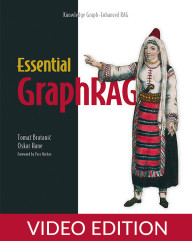books & videos by Tomaz Bratanic
Essential GraphRAG Video Edition
Essential GraphRAG shows you how to build and deploy a production-quality GraphRAG system. You’ll learn to extract structured knowledge from text and how to combine vector-based and graph-based retrieval methods. The book is rich in practical examples, from building a vector similarity search retrieval tool and an Agentic RAG application, to evaluating performance and accuracy, and more.
Graphs and Network Science: An Introduction
Featuring Chapter 1 from Manning’s upcoming book, Graph Data Science by Tomaz Bratanic, this free mini ebook lays the first bricks in your graph data science foundation with an introduction to network science, graphs, and graph analytics. Through illuminating examples, beautifully detailed images, and the author’s clear and passionate explanations, you’ll appreciate the amazing connections all around us and be eager to take the next step in your graph data science journey.

